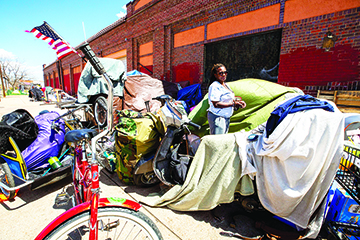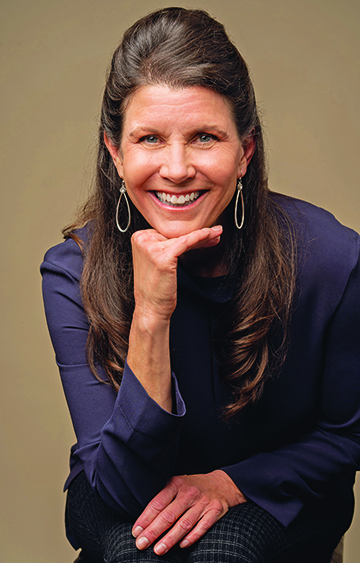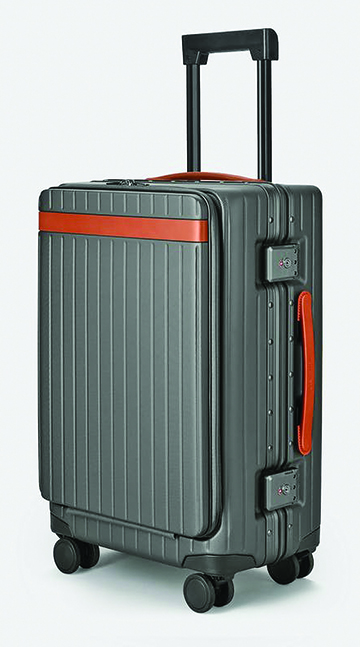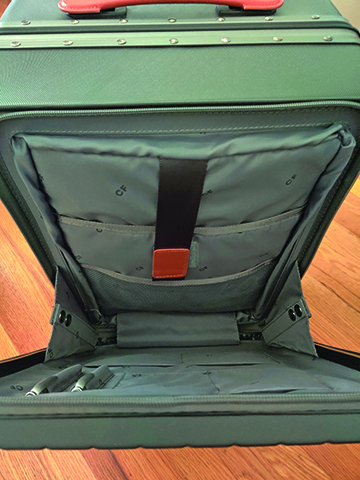
by Glendale Sports Center | Sep 28, 2022 | Glendale City News
by Eileen Eastridge, for the YMCA of Metro Denver

Eileen Eastridge, left, and her Livestrong class at the Littleton YMCA.
On June 22, 2020, (my daughter’s birthday), I was diagnosed with stage 4 metastatic breast cancer. The cancer was found in my breast, lung, and liver, as well as boney areas of my L3, sacrum, and left iliac. My L3 had broken and collapsed twice, and I was in severe pain and had difficulty walking.
My family and I were shocked and devastated at this news, but I did feel a sense of relief to finally know the reason for the symptoms I was experiencing. This diagnosis is a terminal one, which means that I will be dealing with treatment, symptoms, and side effects for the rest of my life, however long that may be. My husband and I discussed that we want the main perspective for my care to be “quality of life.”
The doctor prescribed a series of radiation treatments to the boney lesions, which was grueling, and made it necessary to use a walker. The radiation, coupled with monthly injections, provided miraculous results, and my bones and nerves have healed significantly.
I was also prescribed a hormone blocker and an oral chemo, which I am blessed to be able to take at home each day. This combination has done above and beyond what was expected and has even shrunk my tumors. Unfortunately, these medications come with side effects, including physical stiffness, fatigue, and low moods. I was getting weaker and weaker, and the sadness was becoming a real problem.
To help alleviate the side effects, my doctor gave me information about the LIVESTRONG at the YMCA program at the YMCA of Metro Denver, and I joined the group in December 2021. This program is a free 12-week program for cancer survivors to rebuild health and build community.
I expected to exercise and was happy to have accountability to help keep me on track. However, the icing on the cake came in the social support I found. The LIVESTRONG group is a strong dose of the very best medicine! I found a new community of supporters who understood what going through cancer is really like.
According to research from the Yale Cancer Center and Dana-Farber/Harvard Cancer Institute, participants in the LIVESTRONG program at the YMCA experience improved fitness and quality of life, as well as significant decreases in cancer-related fatigue. We all know that exercise can help you feel better no matter your age or skill level. However, it is especially important for people living with cancer.
LIVESTRONG at the YMCA classes teach exercise methods that are safe for people who have cancer. Over the 12 weeks of the program, the group became stronger, more flexible, and more energetic. The instructors are trained in cancer survivorship, post-rehabilitation exercise, and supportive cancer care. Survivors receive a membership at the YMCA for the duration of the program.
If cancer has impacted your life, this class can help. To learn more, visit denverymca.org/livestrong.

by Charles Bonniwell | Sep 28, 2022 | Editorials

We now know that Denver Mayor Michael Hancock is planning to leave the City and County of Denver for Miami, Florida, at the end of his 12 years of wreckage. It also appears that large sections of the Denver business community have decided to abandon the city as well. The Denver Post reported on August 23rd of this year that restaurants are leaving Denver due to rent hikes and labor shortages. A report from the Downtown Denver Partnership shows the downtown workers are refusing to return to work, with only half the number of office workers coming to downtown compared to 2019, thereby badly hurting Denver’s business district.
Roughly a quarter of the office building space is empty and there are even proposals to turn office buildings into apartment houses. Denver police report that arrests are down 64% over 14 years but crime is up by 50%. The homicide rate is on track to break Denver’s all time high of 100 homicides set in 1981. According to the real estate firm Redfin (and reported in the Denver Business Journal) one in every four Denver homeowners are looking to relocate out of the Denver metropolitan area. Over half of that relocation was due to concerns over, crime, as well as cost of living, taxes, and quality of schools.
Quality of schools is always a key indicator of the future health of a city. There was white flight out of Denver in the 1970s and 1980s over the school issue. The business community began to becom e involved in Denver School board races so that the teachers’ union was not the only voice in an election. Denver began to start and implement charter and specialized schools which were highly popular with Hispanic and Asian communities. But several elections back the business community stopped funding races. As a result, the Denver School Board and the Denver schools are a mess as reported by Glen Richardson on the front page of this month’s Chronicle.
e involved in Denver School board races so that the teachers’ union was not the only voice in an election. Denver began to start and implement charter and specialized schools which were highly popular with Hispanic and Asian communities. But several elections back the business community stopped funding races. As a result, the Denver School Board and the Denver schools are a mess as reported by Glen Richardson on the front page of this month’s Chronicle.
Denver’s 710 KNUS radio host Stephan Tubbs has declared that Denver is “irretrievably lost.” We are not quite so pessimistic. But we do believe that the mayor’s race this spring is, however, absolutely critical. The truly horrific Michael Hancock is finally term limited. If the choice is between a destructive social justice warrior or another high-density whore like Michael Hancock, then Denver will be in real trouble. The business community (sans high density real estate developers) needs to coalesce behind a candidate that actually cares about the many wonderful Denver neighborhoods (and not just how to destroy them); cares about downtown Denver (and not just how to make it a homeless encampment); cares about the parks and open space (and not just how to blow them up for high density projects); understands that ever increasing fees and taxes make the city ever more unaffordable to live in; understands that many Denver cultural institutions are worth preserving; and, most of all, will cause all Denverites to feel welcomed and not just always dividing everything into identity politics.
Is there such a candidate in Denver and will the business community support him or her? The future of the city is depending upon it.
— Editorial Board

by Mark Smiley | Aug 26, 2022 | Editorials
by Mark Smiley

Author: Shelly Slocum is the author of Love and Inspiration from Mom.
Shelly Slocum, a former real estate professional turned author, has released her first book, Love and Inspiration from Mom. The book which is available on Amazon reached number one new release in the self-help category.
The book includes inspirational quotes plus Slocum’s practical tips on how to apply that inspiration on a daily basis in order to live a more optimistic and happier life. “My goal is to change the world one inspired person at a time,” said Shelly Slocum, author of Love and Inspiration from Mom. “I do think most people would like to lead a more inspired and optimistic life; it’s hard to do that when you are in the midst of all the struggles we go through. This just gives you some inspiration every day and some practical tips on what you can do today no matter what you’re going through to live that inspired life. I think people are thirsty for a little love and inspiration.”
The inspiration for the book came six years ago when her eldest daughter lived through a torturous experience. “Fortunately, I was in a position with my real estate business that I could drop everything and hand it off to my business partner and she kept my business going,” said Slocum. “I went out to California where my daughter was living and literally helped her get out of bed every day for weeks. It was a very traumatic time but when she was strong enough to go back to work, I would send her an inspirational quote every morning in a text and then I would add a couple of tips on how she could apply that in her day and then signed it ‘Love, Mom.’ I would do that every day for months. She told me I needed to put this in a book because not everybody has somebody that can do that for them when they’re down.”
Life has come with many challenges and blessings. As a non-smoking lung cancer survivor, Slocum believes she has been given the gift of time and has made it her mission to spread more love and inspiration in the world, and to be the spark that helps people change their lives for the better.
So far, reviews have been positive from those who have read it. “I love this book!,” said Cindy Gotchey. “The quotes and Shelly’s insight and interpretation of each are a thing of beauty. I have read a lot of self-help books and daily inspirationals and this is as good or better than any I have read. Shelly’s life outlook is

Self-Help Book: Love and Inspiration from Mom is available on amazon.com and Barnes & Noble and reached #1 for new books in the self-help category.
inspiring!” “I believe everyone who reads these treasures of wisdom and daily gems will find joy, hope, and a deep breath of peace like I did,” said Barb Haines.
“This book helped me feel the intricacies and depths of love, from the love of a daughter to the love of one’s self,” said Karen Grimm. “Shelly’s interpretation of these meaningful quotes filled a gap in my heart where I’ve been missing my mom’s guidance and encouragement since she passed away. I can’t wait to share this treasure with my own daughters!”
Jack Canfield, co-author of the Chicken Soup for the Soul series wrote the foreword for Love and Inspiration from Mom and describes it as a “warm hug in a book!” “When we wrote Chicken Soup for the Soul, our mission was to change the world one story at a time,” said Jack Canfield in the Foreword. “That’s the power of Love and Inspiration from Mom; together we are making the world a better place one story and one inspired person at a time.”
Having Canfield write the Foreword gave the book a definite boost in sales and the two-hour book signing at Barnes & Noble in Glendale the weekend of July 16 was a success.
Slocum has been married to her high school sweetheart for 39 years and has two daughters. She now savors the ultimate reward for parenting which is being MiMi to her three grandchildren. To connect with Shelly, please visit her website: www.love andinspiration.org.

by Glendale Sports Center | Aug 26, 2022 | Glendale City News
by Elias Jacobson, for the YMCA of Metro Denver
 Many people encounter times in their lives where things get really rough. My difficult period came about 10 years ago. I had lost my sister suddenly, and a short time later my brother was diagnosed with an aggressive cancer, so I decided to move my life from California to Denver to support my parents. To cope with the stress coming at me from everywhere, I developed some unhealthy habits and soon found that my health and well-being had been severely impacted. In 2018 my brother passed away, and my doctor told me a Type II Diabetes diagnosis was imminent unless I took immediate action.
Many people encounter times in their lives where things get really rough. My difficult period came about 10 years ago. I had lost my sister suddenly, and a short time later my brother was diagnosed with an aggressive cancer, so I decided to move my life from California to Denver to support my parents. To cope with the stress coming at me from everywhere, I developed some unhealthy habits and soon found that my health and well-being had been severely impacted. In 2018 my brother passed away, and my doctor told me a Type II Diabetes diagnosis was imminent unless I took immediate action.
I realized that I needed to make significant changes in order to reclaim my physical and mental health. I yearned to get back to being physically fit and mentally sharp. I was blessed with longevity genes, if and only if, I took care of them! As a kid, I attended summer baseball camps and swim programs at the University Hills YMCA. I had enjoyed the Y’s diverse offering of programs growing up, and I made many friends. Those positive memories led me to check-out the Y’s adult programs. I knew the Y would support me in developing a long-term wellness plan with a full array of classes and staff to ensure long-lasting, sustainable results.
When I was younger, I loved long-distance cycling, so it was a great place to begin my journey back to health. The off-street trails located near my home made it a safe, easy way to ride anywhere in town. I started seeing the health benefits almost immediately, and the more I rode, the more I was motivated to continue my cycling. I also began to meet like-minded fitness friends at the Y. The camaraderie further motivated me to continue this healthy lifestyle choice, leading to my first 50 lbs of weight loss! It became easier to keep myself motivated as time went on.
In 2021, I joined the Y’s year-long Diabetes Prevention Program (DPP) where participants are supported by a Lifestyle Coach and peer group in losing weight, learning about diabetes-specific nutrition, becoming more active, managing stress, and staying motivated. This program was exactly what I needed to augment my return to bicycling. The program helped me get my A1C under control, and I have maintained a healthy A1C range ever since with the great tips I learned through the program.
I also joined the Y’s Power Your Potential (PYP) program, a 12-week small group training experience. I loved that the program included an outstanding fitness coach along with super supportive teammates who, like me, were older and struggling with similar health and wellness issues. There was a strong nutritional component with this program as well. The Y’s nutrition staff is conversant with every diet obstacle you could face. The healthy tips and tricks they provide help you safely navigate the ins and outs of fast-food restaurants and grocery stores. This comprehensive nutritional support helped me reeducate myself on how to shop, prepare, and consume a balanced healthy diet.
I am grateful for the Y’s health and wellness programs, because they helped me regain my physical strength, renewed my energy, and helped give me a positive mental outlook. Moreover, they provided an accepting and comfortable place to form a supportive community devoted to staying healthy. I found the home-away-from-home I had been searching for at the Y. My Y friends are great influences and motivators. We keep each other accountable to our goals, yet we’re there to support a teammate with helpful suggestions whenever they have a setback.
When I started my journey back to a healthier, happier me, I weighed 280 lbs. Through lifestyle changes and the Y’s diverse health and wellness offerings, I’m proud to have achieved a total weight loss of 90 lbs. There were other unexpected benefits too; my knee pain slowly diminished because I wasn’t hammering my knees with the extra 90 lbs. That was a huge WOW for me! My friends who had been through knee replacement and the strenuous post-surgery physical therapy said if they could do it over they would have tried a diet and fitness approach first.
With the Y’s multi-faceted wellness improvement programs, the Y will be my “go-to” resource for maintaining the goals I’ve accomplished to date. Between the state-of-the-art EGYM, DPP, and PYP, I now find myself at the Y four times a week. I haven’t felt this good in over 10 years, and I attribute this to the ongoing motivation achieved through self-reflection, connections with like-minded people, and a sense of belonging to a community committed to lifelong health and wellness.
Each goal I completed along my path had a cumulative effect on my overall motivation — it only got stronger. It’s wonderful to know that the Y has been there for me all these years — from summer camps as a kid to helping me regain my health as a 70-year-old adult. With a wide range of activities and programs, the YMCA of Metro Denver is truly a welcoming and transformative place where any person can discover their own unique path to health and wellbeing.
Interested in the YMCA’s Power Your Potential program? There’s still time to register — visit denverymca.org/programs /fitness-programs/power-your-potential.

by Mark Smiley | Jul 27, 2022 | Travel

Lady Bug: The Ladybug is big and strong (but doesn’t realize it) and full of life. Unlike all the other insects in the community she is not part of a family. She’s all alone and lonely, and she’s secretly waiting for something wonderful to happen in her life—something like love. When The Foreigner arrives carrying a strange egg she’s excited by the possibility that her life – and everyone else’s – could be about to change.

Triumphant Return: Cirque du Soleil returns to Denver for the first time in three years. Cirque Ovo will be at the ball Arena from September 8-11.
Ovo Show at Ball Arena Will Be First in Front of Denver Audiences Since Corteo in August 2019
By Mark Smiley
Cirque du Soleil returns to Colorado with its high-energy and high-acrobatic production OVO. Ovo is an exciting Cirque du Soleil experience, that features an intrusion into a new day in the life of insects; a non-stop show of energy and movement. Cirque du Solei shows are famous for their acrobatics and this show is no exception, highlighting the unique personalities and abilities of selected insect species. OVO explores the beauty of biodiversity in all its contrasts and vibrancy. From mighty crickets bouncing off trampolines to a hypnotic spider contorting inside her web, OVO exudes extraordinary showmanship.
“We’re very excited to be coming back especially after the last couple of years that we all had to experience around the world,” said Janie Mallet, Cirque OVO Publicist. “This show has a high acrobatic level and lots of variety. It really is a nice story about friendship, curiosity, exclusivity and love.”
Ovo has been out since 2009. It was first created for the big top and then in 2016, transformed for the arena shows. After what Cirque calls “Intermission” during the COVID-19 pandemic, the team of 100 artists, musicians, and backstage personnel which comprises 25 different nationalities, worked on the show for 3 months before hitting the road again. The artists especially had to find creative ways to stay in top physical shape during the pandemic and the three months of preparation allowed for them to get in that top form. Since its opening in Montreal in 2009, OVO has performed in fr

High Wire Act: Through show-stopping acrobatics highlighting the unique personalities and abilities of selected insect species, OVO explores the beauty of biodiversity in all its contrasts and vibrancy.
ont of more than 7 million people in 155 cities in 26 different countries.
Cirque began performing in front of live audiences in June 2021 in Las Vegas. The shows under the big top re-launched last Fall and how the arena shows are back. “People have been craving live entertainment,” said Mallet. “They’re so supportive and so vocal and so present with us. It’s been amazing coming back and performing live.”
OVO will perform in Colorado at: Budweiser Events Center in Loveland from August 26 to 28, 2022, Broadmoor World Arena in Colorado Springs from September 1 to 4, 2022 and the Ball Arena in Denver from September 8 to 11, 2022. Visit cirquedusoleil.com/ovo for more information and to purchase tickets. Follow #OVOCirque and #cirquedusoleil on social media: Facebook, Twitter, Instagram, YouTube, and TikTok.
Photo Credit : Pat Beaudry, Max Bocanegra, Randy Cremean & Vlad Lorenzo

by Mark Smiley | Jul 22, 2022 | General Featured
by Mark Smiley

Durable: The Carl Friedrik Carry-on Pro’s wheels move 360 degrees and are silent and durable. Its hard-shell makes it a nearly indestructible piece of luggage without sacrificing style.

Inside The Suitcase: Each side is an open compartment equipped with compression straps.
The Carl Friedrik Carry-on Pro, a polycarbonate carry-on suitcase, is intended for professional travelers and even the casual one that is spending a few nights away from home. This carry-on bag is one of the sturdiest on the market with its hard-shell exterior. Even with its sturdy construction, it is a stylish piece of luggage.
It features a rugged metal frame to create a sturdy and robust structure but with soft, premium Italian leather detailing. The wheels move 360 degrees, are silent and durable, and are made by Hinomoto, a company which, according to obsessive fliers, is a standard-bearer of quality caster-making.
On the outside of the bag, travelers will find a convenient pocket, making it easy to access electronics and travel documents. On a quick trip to a local resort, we used the outside pocket for a tablet but that slot is also large enough to fit a laptop computer. The bag is secured by combination locks, intended to keep valuables safe and protected when traveling.

Outside The Suitcase: On the outside of the bag, travelers will find a convenient pocket, making it easy to access electronics and travel documents.
Small in size, the Carl Friedrik Carry-on Pro meets the standard cabin restrictions for most U.S. and European carry-on dimensions. The bag also features a removable compression pad which can be used with the provided compression straps. There is a separate laptop compartment, a smaller pocket, and an area to store pens and chargers. The bag even features an optional outside USB charging port and battery to keep mobile phones and laptops running throughout the day.
Internally, each side is an open compartment equipped with compression straps. It includes one removable compression pad with a pocket, to be used in tandem with the compression straps.
For those in the market for a small carry-on suitcase that will stand the test of time and is made from quality materials, consider the Carl Friedrik Carry-on Pro. Visit www.carlfriedrik.com for more information or to purchase one of their suitcases.















